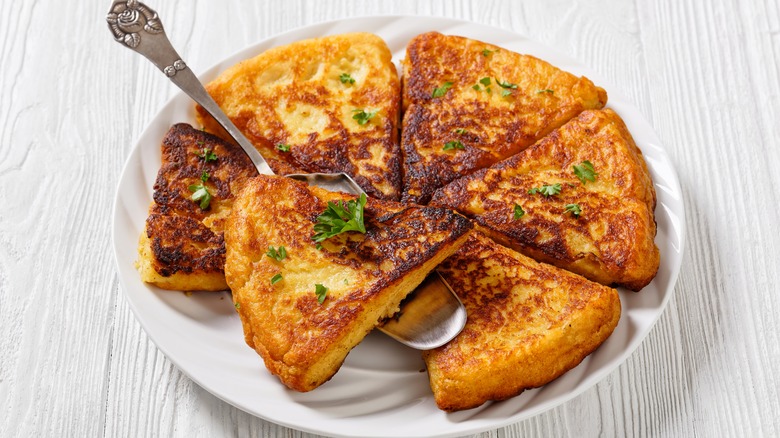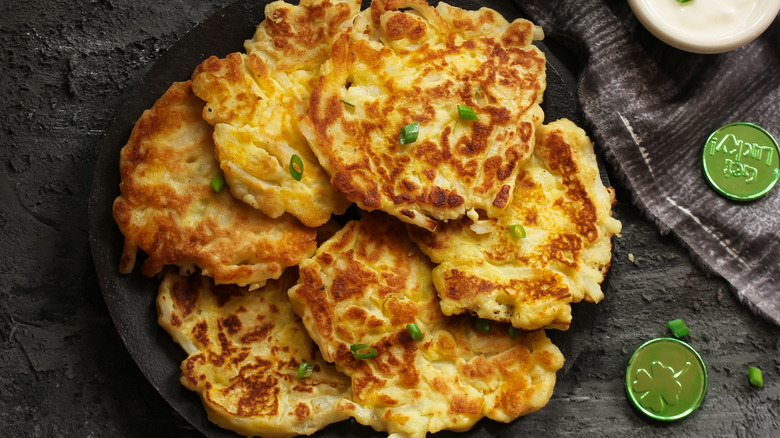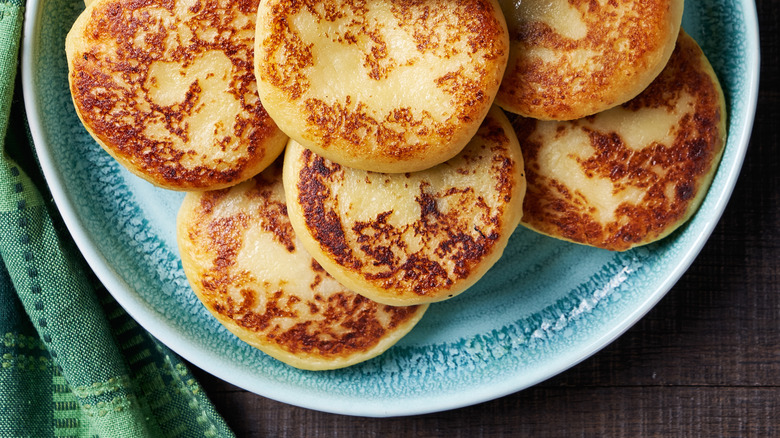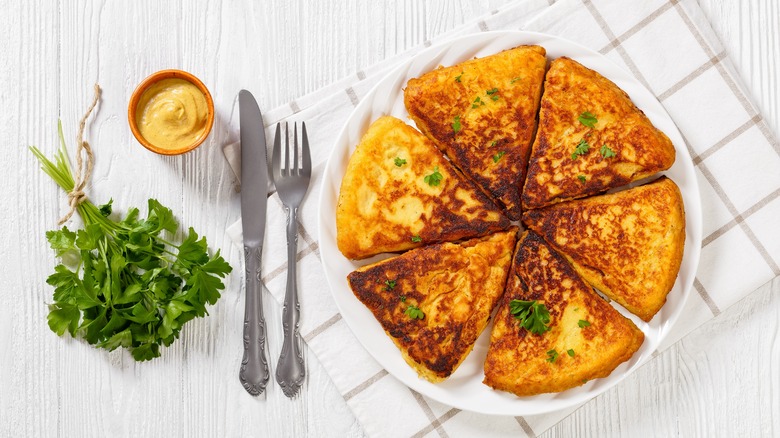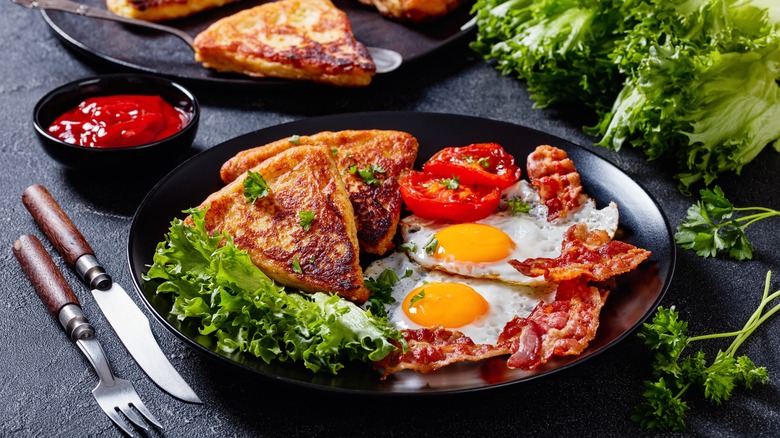The Buttery Potato Cakes Lovers Of Irish Literature Will Truly Appreciate
We may receive a commission on purchases made from links.
If your knowledge of Irish cuisine doesn't extend too far beyond corned beef and cabbage and the greens-laced mashed potatoes known as colcannon, then boy, do you have a lot to learn — and taste. Although not among the world's most-craved cuisines — those would be Italian, Chinese, and Japanese, according to a YouGov poll of more than 25,000 people around the globe — Irish food is full of tasty delights. These span from creamy nettle soup to flaky pies filled with stew to rustic pork sausages with applesauce — and few people on earth know more about these dishes, and how to make them, than Darina Allen.
Ireland's best known chef, according to the blurb on the back on her revered encyclopedic guide to Irish cookery entitled "Irish Traditional Cooking," Allen has been a steadfast promoter of Irish ingredients and techniques. In 1983, she founded the Ballymaloe Cookery School in Cork, which provides students with an intensive education rooted in Irish cooking principals. She's also been involved in the Slow Food Movement and back in 2012, timed with the release of "Irish Traditional Cooking," Allen shared her recipe for simple and delicious potato and caraway seed cakes with Tasting Table. One year later, she helped launch the Ballymaloe Literary Festival of Food and Wine (via Ballymaloe Cookery School).
Potato cakes are a staple part of Irish cuisine
A hallmark of Irish cuisine, the humble potato has been featured prominently in the nation's dishes since its introduction to the island back in the mid-17th century. According to the Irish Canadian Cultural Association of New Brunswick, the root vegetable was able to tolerate Ireland's often-poor soil quality, stored very well under a variety of conditions, and introduced many essential vitamins into the diets of the country's lower classes. Today, plenty of iconic Irish dishes continue to utilize potatoes, from potato casserole to corned beef hash.
Irish chef Darina Allen's potato and caraway seed cakes are but one variation on a vast category of potato cakes. Also called potato scones (via Irish American Mom) and potato farls (via Moorlands Eater), potato cakes utilize mashed potatoes — which can be made from scratch or used up from leftovers — and can be flavored with many ingredients besides caraway seeds, from onion powder to the fresh chives called for in Tasting Table recipe developer Jaime Shelbert's version.
Potato cakes are patted into one big round, cut into triangles or circles, and then cooked. There's even a closely related and yet different category of potato cakes called boxty, which incorporates grated raw potato into the mashed potatoes.
Potato cake ingredients and technique
Let's get back to Irish chef Darina Allen's potato cake recipe, as it's a good, solid example of potato cake ingredients and technique. The recipe calls for a batch of mashed potatoes made from one and a half pounds of Yukon gold potatoes, which are medium-sized starch potatoes, according to Martha Stewart. In Allen's version, the potatoes are cooked whole and then peeled, but you can also peel the potatoes and then chunk them for cooking (via Moorlands Eater). They're mashed with a fork, and then some chopped onion sautéed in butter is added to the mix along with caraway seeds, parsley, salt, and pepper.
Flour is added to the potato cake mixture in order to bind the cakes together, and then the dough is kneaded, patted out into a round that's three quarters of an inch thick, and cut into circles using a drinking glass or cookie cutter. The cakes are then cooked on a buttered skillet until golden-brown on each side and served hot.
Darina Allen's potato cakes take their inspiration from an 1899 work of fiction
Irish literature is pretty storied, with heavy-hitting and highly-regarded authors in the canon, including poet William Butler Yeats, bon vivant Oscar Wilde, and the legendary James Joyce, author of 1922's "Ulysses" (via Britannica). And in 1899, two women cousins — who adopted the masculine-sounding pen names of E. Œ. Somerville and Martin Ross — published "Some Experiences of an Irish R.M.," a collection of humorous tales centering on the misadventures of a countryside magistrate named Major Sinclair Yeates (via Goodreads). Among the vignettes of fox hunts, sailing, and whiskey-drinking, there's the short recollection made by Yeates' long-suffering landlord Flurry Knox — which centers on some particularly delicious potato cakes he once enjoyed.
"While I live I shall not forget her potato cakes," Knox says in the book (via BBC). "They came in hot from a pot-oven, they were speckled with caraway seeds, they swam in salt butter, and we ate them shamelessly and greasily, and washed them down with hot whiskey and water."
It's from this literary repast that Irish chef Darina Allen took her inspiration for her potato and caraway seed cakes, according to the BBC.
What to eat with potato cakes
We've gotten a sense of what Irish potato cakes are, how to make them, and even a little bit of the literary backstory behind them. But the question remains: What do we eat with them?
The answer is pretty much anything, according to Irish American Mom. A natural choice for breakfast in Ireland, the cakes are often enjoyed as part of a traditional fry-up, alongside bacon, sausages, eggs, mushrooms, and fried tomatoes. Or, you can dig into the cakes at lunch, serving them with pork chops, salmon, or ham.
Tasting Table recipe developer Jaime Shelbert agrees that there are few Irish dishes more versatile than potato cakes, noting, "These parallel with your favorite Irish dish or alongside sauerkraut or any other cabbage dish. Popular toppings include sour cream, applesauce, caramelized onions, or savory jams."
So the next time you make mashed potatoes, you just might want to prepare a double batch to have plenty on hand for a round of potato cakes.
